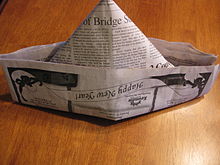Black and White (picture book)
The book tells four overlapping stories, each drawn with a distinct visual style: "Seeing Things", about a boy on a train trip by himself, "Problem Parents", about siblings whose parents behave differently one night, "A Waiting Game", about people waiting for a train, and "Udder Chaos", about cows who escape and then return to their field.
The book is designed to be interpreted in a number of different ways and can be frustrating for readers who wish to have a simple narrative they can absorb without thinking too much about.
Macaulay wanted each story to look different—"I did everything I could to visually separate each fragment"—including choosing a different medium and set of characters for each.
At one point in the journey, the train's progress is stopped and he is briefly joined by what the text refers to as an "old woman" but which the illustrations suggest might be the robber from "Udder Chaos".
Looking out the window, the boy is unable to tell what has stopped the train and laughs when the driver attempts to chase away what appear to be boulders.
The boy then notices "strange creatures" standing near the train who are responsible for the torn paper and singing.
The brother joins in the fun more quickly than his sister, who unsuccessfully attempts to jolt her parents back to normal.
The narrator is horrified when her brother suggests they go out to dinner dressed as they are and manages to convince the other family members to leave the costumes at home.
In the end, the narrator admits the experience is fun, though she finds her parents' antics "exhausting" when they ask her about her homework as she's heading to bed.
After the train leaves with the passengers, the only characters left are a robber and the station master who is cleaning up the mess from the newspapers.
[5] The printing technology enabling this kind of book with its multiple illustration styles and typesets was relatively new at the time of Black and White's publication.
[2] The reader is primed to interact with the writing and illustrations by the unattributed warning on the title page to "carefully" inspect the different stories.
[16] The final page, featuring a hand picking up the train station from "A Waiting Game" and the nose of the dog from "Problem Parents," can have multiple interpretations.
Kimberly Olson Fakih praised, "Macaulay's avalanche of creativity" in the Los Angeles Times.
[3] Similarly, Karen Litton writing in School Library Journal suggested the book was confusing and "more show than go" in a mostly negative review.
[19] This confusion was seen in a more positive way by The Horn Book Magazine's Mary Burns, "perhaps there is no one explanation but rather a series of playful allusions and clever delusions which are meant to be enjoyed by the freewheeling and free-spirited as an escape from the ordinary.
[6] Teachers who do choose to use the book can do so in a way that demonstrates that the whole is greater than the sum of its parts and as an example of the value gained through group collaboration and discussion of literature.
[16] Black and White was seen as inspiring future books such as The Stinky Cheese Man and Other Fairly Stupid Tales by Jon Scieszka and Lane Smith.

